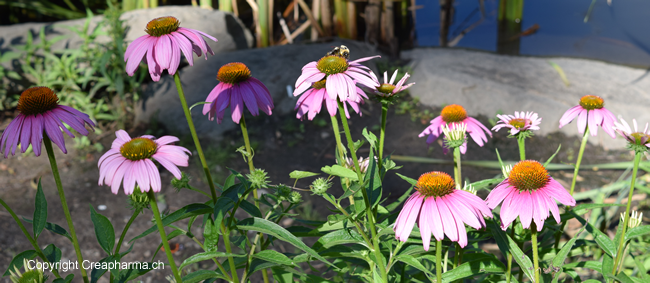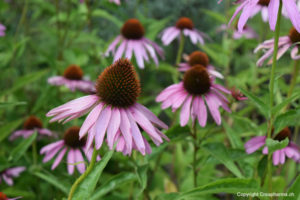Echinacea
Summary
Herbal plant stimulating the immune defences, with an action mainly in the treatment of cold and flu, often comes in the form of capsule, tablet or juice.
Common names: Echinacea, Black Sampson, Rudbeckia, Coneflower, Purple Coneflower
Scientific name (Binomial name): Echinacea purpurea DC (but also other species like Echinacea angustifolia and Echinacea pallida)
French name: échinacée
German name: Roter Sonnenhut, Echinacea, Purpursonnenhaut
Italian name: echinacea
Portuguese name: equinácea
Spanish name: equinácea
Asteraceae
– Polysaccharide
– Essential oils
– Alkylamides
– Polyacetylenes
– Glycoproteins
– Flavonoids: derived from caffeic acid
Fresh aerial parts (flowers), roots, leaves (especially for its supposed healing effect, also read below under Remarks). The whole plant can be used in phytotherapy.

Immunostimulant, immunomodulator, antibacterial, antiviral.
Prevention of infections such as flu or cold, this effect is however contested. Read also under Remarks below
Reduce the duration of symptoms of the cold (e.g. cough, fever, sore throat) or flu. Read under Remarks
Very rare and often in high doses: itching, dizziness, nausea (in case of high dose), diarrhea.
Allergy to this plant and other plants of the Asteraceae family, autoimmune diseases (AIDS, leukopenia, lupus, rheumatoid arthritis), tuberculosis.
Possible interaction with certain drugs such as itroconazole, lovastatin (a statin) and fexofenadine. Birth control pill.
– Echinacea tablets
– Echinacea capsule
– Echinacea tincture (if you suffer from cooling, take 1 to 2 ml of this tincture every 2 hours, possibly mix with a little water)
– Herbal tea of sage and equinacea (in case of sore throat)
– Echinacea syrup
– Echinacea Decoction
Echinacea grows mainly in Europe and the American continent. The plant is native to the United States.
All of the world’s echinacea production comes from cultivation based mainly in North America and Europe, i.e. the plant is not harvested in the wild. As echinacea was overharvested in wild prairies across North America, it is better to harvest in prairies.
Echinacea generally reaches a height between 60 and 180 cm. It is a perennial plant, i.e. it can live several years.

Echinacea flowers are harvested preferably in spring (note that flowering can take place in Europe until September), echinacea roots are harvested in late autumn between the 3rd and 4th year of life of the plant. Echinacea roots are harvested when the flowers are fully open, to guarantee a maximum quantity of active ingredients.
It is important to harvest echinacea roots by hand. The roots must be dried and not eaten fresh. When you harvest the roots, remember to leave a few roots so that the plant can grow back.
- According to the latest scientific studies, Echinacea would not prevent cold or flu, that is in any case the opinion of the famous Mayo Clinic and the National Geographic. This media notes that some studies have shown the effectiveness of echinacea in shortening the duration of cold symptoms from 1 to 2 days. To benefit from the effects of this plant, it must be consumed as soon as the first symptoms of cold appear.
- The American Indians used at least 3 different species of echinacea. The Cheyenne used for example echinacea in the form of infusion based on leaves and roots. The American Indians mainly used echinacea for its healing effect, both the roots and the leaves.
Text written by Xavier Gruffat (pharmacist ETH Zurich, Switzerland). Pictures : Creapharma.com (Pharmanetis GmbH)

